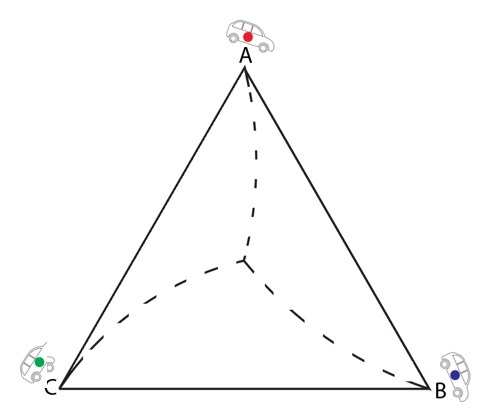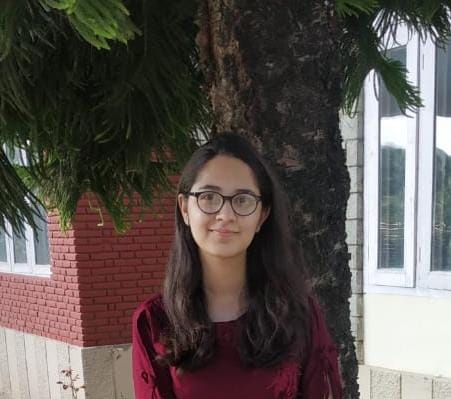
 Data Structure
Data Structure Networking
Networking RDBMS
RDBMS Operating System
Operating System Java
Java MS Excel
MS Excel iOS
iOS HTML
HTML CSS
CSS Android
Android Python
Python C Programming
C Programming C++
C++ C#
C# MongoDB
MongoDB MySQL
MySQL Javascript
Javascript PHP
PHP
- Selected Reading
- UPSC IAS Exams Notes
- Developer's Best Practices
- Questions and Answers
- Effective Resume Writing
- HR Interview Questions
- Computer Glossary
- Who is Who
Time Required to Meet in Equilateral Triangle
An equilateral triangle is a triangle with all of its sides equal in length. As the three sides are equal, the three angles opposing the equal sides are also equal in magnitude. As a result, it is also known as an equiangular triangle, with each angle measuring 60 degrees. The centroid of an equilateral triangle is the point where its three medians intersect. In an equilateral triangle, all three sides are of equal length and all three angles are of equal measure, so each median will intersect at the same point, which is the centroid.
Problem Statement
Given length of sides of the equilateral triangle (d), and constant velocity(v) of each car tagged on the vertices of the triangle, the task is to find out the time after which they meet, if they start moving towards their right opposite, forming a trajectory. The following diagram represents the problem statement.

Sample Examples
Input
d = 36, v = 49
Output
0.489796
Explanation
Substituting the values of d and v in the formula t=(2*d)/(3*v), we get,t=(2*36)/(3*49)=0.489796
Input
d = 12.5, v = 28
Output
0.297619
Explanation
Substituting the values of d and v in the formula t=(2*d)/(3*v), we get,t=(2*12.5)/(3*28)=0.297619
Input
d = 10, v = 10
Output
0.666667
Explanation
Substituting the values of d and v in the formula t=(2*d)/(3*v), we get,t=(2*10)/(3*10)=0.666667
Solution Approach
Car A is pursuing Car B while adjusting its direction to face B. Car B is also changing direction while pursuing Car C, and Car C is pursuing Car A. Due to symmetry, they will eventually meet at the centroid.
If we consider a small time interval during which the directions remain unchanged, then Car A moves along the line AB with velocity V. Although Car B is not moving exactly towards Car A, it has a velocity component in the direction of Car A, which is v(cos 60). Thus, the rate at which Car A approaches Car B is (v + (cos 60)) = 3v/2.
Although the directions of the cars are changing, their speeds are constant at v, and their relative positions remain the same. Therefore, the rate of approach is constant at 3v/2.
Given an initial separation distance of d, they will meet at a time t = 2d/3v.
Pseudocode
Initialize the velocities of cars A, B, and C to v.
Initialize the initial separation distance between cars A and B to d.
Since the triangle is equilateral, all sides measure the same.
Calculate the time t at which they will meet using the formula t = 2d / 3v as discussed above.
Output the value of t.
Algorithm
Function timeOfMeeting()
Define D
D = (2 * d) / (3 * v)
return D
Function main()
Initialize velocity v
Initialize initial separation d
Define t
Initialise t = Function call timeOfMeeting()
Print output t
Example: C++ Program
The following C++ program, a function timeOfMeeting() is defined, which takes the velocities of the cars (v) and the initial separation distance between cars A and B (d) as input parameters. The function calculates and returns the time of meeting using the formula provided in the problem statement.
In the main() function, the values of v and d are initialized, and the timeOfMeeting() function is called to calculate the time of meeting. The result is then printed.
// C++ program to find the time taken by the three cars to meet.
#include <iostream>
using namespace std;
// Function to calculate time of meeting
double timeOfMeeting(double v, double d){
double D = (2 * d) / (3 * v);
return D;
}
// Main function
int main(){
double v = 10.0; // velocity of all three cars
double d = 100.0; // initial separation distance between cars A and B
double t = timeOfMeeting(v, d); // call function to calculate time of meeting
cout << "The cars will meet at time " << t << endl;
return 0;
}
Output
The cars will meet at time 6.66667
Time and Space Complexity
Time complexity: O(1)
The program has a time complexity of O(1), since the time it takes to execute does not depend on the input size. This is because the program only performs a single arithmetic calculation in the timeOfMeeting() function, which has a constant time complexity of O(1).
Space complexity: O(1)
The program has a space complexity of O(1), since the amount of memory it uses does not depend on the input size. The only memory used by the program is for the double variables, which have a fixed size and do not change based on the input size.
Conclusion
In the above article, we discussed the time required by three cars moving in an equilateral triangle if they start moving towards their right opposite, forming a trajectory. The initial separation distance and velocity of the three cars is provided to us. The concept of the problem was explained through suitable examples. The article discusses the algorithm, pseudocode and the C++ program code for the given problem statement in great detail and also analyzes its time and space complexity.

